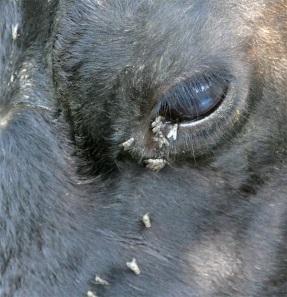The Face Fly
By Dr. Lee Townsend, Extension Entomologist
 Horn flies and face flies are the key pasture flies that Kentucky cattle producers face each year. Both provide unique control challenges, but the face fly is the more difficult one to manage. There are two main reasons: the small amount of time spent on animals and hard-to-treat feeding sites.
Horn flies and face flies are the key pasture flies that Kentucky cattle producers face each year. Both provide unique control challenges, but the face fly is the more difficult one to manage. There are two main reasons: the small amount of time spent on animals and hard-to-treat feeding sites.
Most of the time, face flies are resting on vegetation, fence rails, or other surfaces. They spend only about 10% of their time on animals, just long enough to feed. Research estimates indicate that less than 5% of the face flies near a herd of cattle are on the animals at any one time. Visits are limited to around the eyes and muzzle where they can quickly blot up protein-rich secretions. The face flies’ sponging mouthpart has small, rough spines that scratch tender eye tissue, causing tears to flow. These flies also will feed at wounds or on milk on calves’ faces.
Several insecticides can “suppress” face fly numbers, but no treatment will keep cattle free from this pest. Delivery is the key to best results. Forced-use dust bags, fly flyps, and applicator kits for mineral feeders are among the best ways to put the insecticide where it needs to be, on the face and muzzle. Insecticide ear tags containing the active ingredients coumaphos+diazinnon, cyfluthrin, or cyhalothrin also have provided good protection against face flies in field trials. While one tag can be enough for horn fly control, two tags per head have been best against face flies. It is important to treat calves and check product labels for age restrictions, as they vary with product. Regardless of the treatment approach, face flies may not pick up a lethal dose of insecticide. However, if the product is on target, they are likely to be repelled by the insecticide. That will reduce irritation and eye injury.
Face flies are annoying and can interrupt grazing during the day. However, cattle will compensate by grazing at night when the flies are not feeding so no real effect on gains has been demonstrated from nuisance value. These are important flies though because they can play a role in in the spread of pinkeye. Their importance varies with the situation and year. The flies not only carry the bacteria on their bodies for 3 or 4 days but also scrape the cornea as they feed. They provide an entry site and can contaminate it with the pinkeye organism. Other eye irritants, such as tall grass, pollen, and sunlight play important roles in the incidence of this disease.
Face flies have been in the U.S. only since 1951 but they have become one of the toughest pasture flies to manage. Female face flies lay their eggs in fresh cattle droppings. The life cycle takes about 2 weeks during the summer, and adult flies live 2 to 4 weeks. Flight range of this insect is about 4 miles so they can move from herd to herd, keeping fly pressure high, even if your control program is good.
Categories:
Summer
Animal Management


